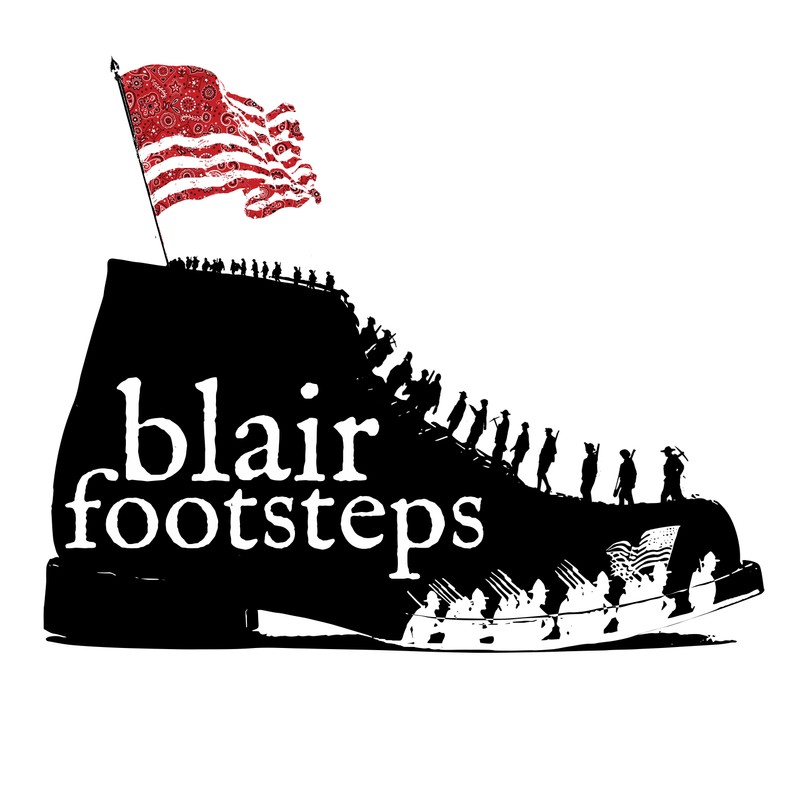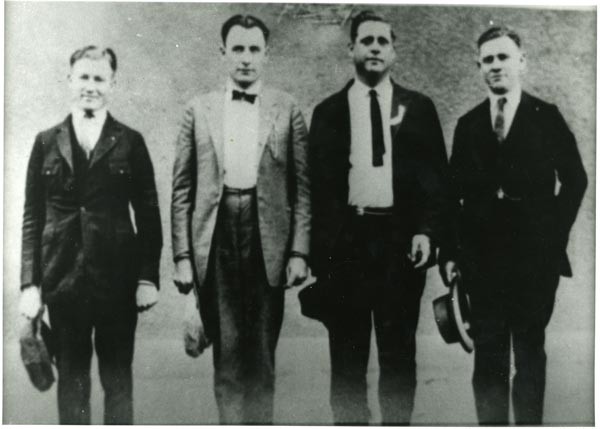Blair Footsteps Tour #2: Racine
Introduction
Text-to-speech Audio
Racine was an important waypoint for armed West Virginia coal miners on their expedition to Mingo County in the summer of 1921. On Wednesday, August 24 they began their advance up Lens Creek. In Racine they reassembled and gathered supplies, many of them camping along nearby Indian Creek. At Racine and neighboring Peytona, they turned to briefly follow the Big Coal River westward before pivoting south again toward Mingo.
-----
This entry is a digital companion to the Blair Footsteps exhibit trail, available to the public from August 30 - September 11, 2021 as part of the Battle of Blair Mountain Centennial. The map location of this entry indicates where the temporary exhibit can be found. The Racine Station of Blair Footsteps is located at the entrance to the baseball field at John Slack Park, across from the swimming pool.
Images

General Henry H. Bandholtz (right) and West Virginia Governor Ephraim Morgan during the 1921 armed crisis.

UMWA leaders of District 17, all of whom figured prominently in the events surrounding Blair Mountain. LEFT TO RIGHT: Bill Blizzard, Fred Mooney, Bill Petry, Frank Keeney

Backstory and Context
Text-to-speech Audio
Advance groups of the miners’ army numbering in the hundreds reached Racine the night of Wednesday, August 24. Some of those in the lead set up camp at the mouth of Indian Creek, slightly south of town, to allow the rest of the column (now spanning 20 miles by some accounts) time to catch up.
By Thursday, alarmed shopkeeper P.D. Gillespie found his general store swarmed by hundreds of armed miners—one of which Gillespie felt certain was holding a hand grenade. While nervously monitoring his shop, Gillespie was also attending to the incessantly ringing telephone. Callers sought any information Gillespie could provide about the miners: how many there were, how well armed, where they were going. The shopkeeper balked when one armed miner warned him not to provide intelligence to callers. Shortly after, the shop’s phone lines were cut and the phone fell silent.
UMWA Local 404 member Ed Reynolds traveled from his local's headquarters in Mammoth to march on Mingo and brought 300 men with him. As Reynolds and his men moved through Racine on Thursday, August 25, they spotted a switch engine with three flatcars idling on the C&O railroad track. Seizing the opportunity, Reynolds boarded the locomotive and commanded the startled crew to fire up the boiler. They were in no position to refuse, and within minutes the train lurched forward with Reynolds and his battalion aboard. The commandeered train raced some 30 miles north by northwest toward the junction at Sproul, where it was stopped by a defiant railroad employee who refused to turn the switch toward Logan, the miners' next objective. Reynolds ordered two of his armed miners to persuade the man, and soon the train was chuffing along the route Reynolds intended.
With so many miners on the march, the situation in West Virginia was rapidly deteriorating. At last the White House administration of President Warren G. Harding acceded to Governor Morgan’s pleas for help. President Harding’s Secretary of War John W. Weeks ordered Brigadier General Henry Bandholtz to Charleston to disperse the mobilized miners. Bandholtz arrived in Charleston at 3 A.M., and after briefly assessing the situation gave audience to Governor Morgan. Morgan had long asserted that Federal intervention was the only solution to the unrest, having requested troops the previous year, and again earlier that week, and had even expanded the request most recently to include aircrafts and heavy armaments. Morgan insisted again that Federal troops were needed, but Bandholtz was skeptical. First, he would need to speak with UMWA leaders Frank Keeney and Fred Mooney.
Bandholtz had Keeney and Mooney rousted from bed and brought to the State Capitol at 5 A.M., then brusquely informed them that he held the pair personally responsible for inciting the miners to advance on Mingo. The General also reiterated the same kind of threat that may have spooked Mother Jones into misleading the miners assembled outside of Marmet three days prior: that if the men could not convince the armed miners to stop their march and go home, then the full weight of the United States Army would be used to extinguish the movement.
Keeney and Mooney were skeptical of their ability to turn the tide of the march, but agreed to try to prevent the type of escalation forbidden by Bandholtz. At dawn Keeney and Mooney hired a taxi and moved south from Marmet, speeding through Racine and other towns along the route. They urged miners along the way to abandon the march and brandishing a formal appeal from General Bandholtz. The union men returned to Charleston with a promising report for the General: despite some resistance, the march was stopped and the miners awaited special trains dispatched by the state to bring them back.
Bandholtz carried out his own reconnaissance later that afternoon. Enduring the rough ride up Lens Creek and to Racine, the General crossed the footbridge over the Big Coal River and appealed to the gathered miners directly. Bandholtz expressed his sympathy with their plight and voiced appreciation that the gathered men were already dispersing, but also reminded them matter-of-factly that the heavy hand of martial law was inevitable if they failed to disband. The miners assured the Bandholtz that they were patriotic Americans—many were even veterans of World War I—who had no intention to go to battle with the United States.
The tension having broken, the remainder of the encounter was friendly and the General left assured that the march had been aborted. Anxious over the lack of will in Charleston to meaningfully address the simmering conflict but satisfied his mission to stop the advance on Mingo was successful, General Bandholtz returned to Washington that evening. It would not be an extended absence.
-----
In late August and early September 2021, a small team of volunteers from the Preservation Alliance of West Virginia will install Blair Footsteps, a temporary outdoor exhibit trail which guides visitors through some of the important sites and events along the route of the miners’ march. The exhibit is funded in part by a grant from the National Coal Heritage Area Authority, and is an official event of the Battle of Blair Mountain Centennial.
Sources
Green, James. The Devil Is Here in These Hills. Edition First. New York, New York. Atlantic Monthly Press, 2015.
Lee, Howard B.. Bloodletting in Appalachia: The Story of West Virginia's Four Major Mine Wars And Other Thrilling Incidents On Its Coal Fields. Parsons, West Virginia. McClain Printing Company, 1969.
Savage, Lon. Thunder in the Mountains: The West Virginia Mine War, 1920-1921. Pittsburgh, Pennsylvania . University of Pittsburgh Press, 1990.
Shogan, Robert. The Battle of Blair Mountain: The Story of America's Largest Labor Uprising. Boulder, Colorado. Westview Press, 2004.
West Virginia and Regional History Center, West Virginia University Libraries
Unknown
